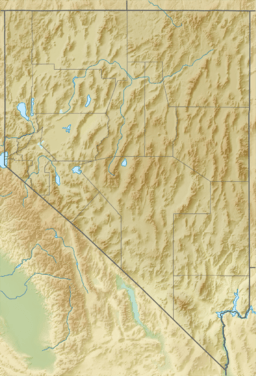Volcanic Hills (Nevada) facts for kids
Quick facts for kids Volcanic Hills |
|
|---|---|
| Highest point | |
| Elevation | 1,963 m (6,440 ft) |
| Geography | |
| Country | United States |
| State | Nevada |
| District | Esmeralda County |
| Range coordinates | 37°58′39.750″N 118°7′9.402″W / 37.97770833°N 118.11927833°W |
| Topo map | USGS Volcanic Hills East |
The Volcanic Hills are a mountain range found in Esmeralda County, Nevada. This area is in the western part of the United States. A mountain range is a group of mountains connected together. The Volcanic Hills get their name because they were formed by volcanoes long ago. They stand tall in the desert landscape of Nevada.
Contents
What are the Volcanic Hills?
The Volcanic Hills are a natural landform. They are part of a larger area called the Great Basin. This region covers much of Nevada and parts of nearby states. The highest point in the Volcanic Hills is about 1,963 meters (6,440 feet) above sea level. That's taller than many big buildings! These hills might not be as famous as some other mountains, but they are an important part of Nevada's geography.
Where are the Volcanic Hills Located?
The Volcanic Hills are in Esmeralda County, Nevada. This county is in the southwestern part of the state. It is known for its wide-open spaces and desert plants. The nearest towns are often small. This means the Volcanic Hills are in a quiet, natural area. They are far from big cities. This makes them a great place for nature lovers.
Why are They Called 'Volcanic'?
The name "Volcanic Hills" gives us a big clue about how they were made. Millions of years ago, this area was very active with volcanoes. Hot melted rock, called magma, pushed up from deep inside the Earth. Sometimes, it erupted as lava onto the surface. Over a very long time, these eruptions built up layers of rock. This created the hills and mountains we see today. The rocks in the Volcanic Hills are mostly volcanic rocks. These rocks tell the story of ancient eruptions.
Life in the Volcanic Hills
Even though the Volcanic Hills are in a desert, life still thrives there. The plants and animals living here are special. They have adapted to the dry conditions.
Desert Plants
You might find plants like sagebrush and Joshua trees. These plants can survive with little water. They have special roots or leaves. Some cacti also grow here. They store water in their thick stems. These plants provide food and shelter for animals.
Desert Animals
Many animals call the Volcanic Hills home. You might see desert bighorn sheep climbing the rocky slopes. Small mammals like jackrabbits and kangaroo rats are common. Birds like roadrunners and various types of hawks fly overhead. Reptiles, such as lizards and snakes, also live here. They are good at hiding from the sun. These animals are part of a delicate desert ecosystem.
Exploring the Volcanic Hills Area
The Volcanic Hills offer a chance to explore nature. Since they are in a remote area, they are perfect for outdoor activities.
Hiking and Nature Watching
People who visit can enjoy hiking. They can walk along trails or explore off-trail. It's a great way to see the unique desert landscape up close. You can look for interesting rocks. You might even spot some of the desert animals. Remember to bring plenty of water. The desert can be very hot and dry.
Stargazing
Because the Volcanic Hills are far from city lights, the night sky is amazing. It's a perfect spot for stargazing. You can see thousands of stars. The Milky Way galaxy is often visible. It's a truly breathtaking sight.
The Volcanic Hills are a fascinating part of Nevada. They show us the power of nature. They also remind us of Earth's long geological history.


